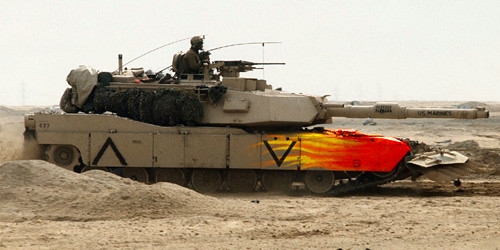I only read the
Armed Forces Journal when one has been left sitting in the lobby to my office for a week or two, so
J. Sigger gets a big hat tip for calling Ralph
"The Hearts and Minds Myth" Peters's
latest commentary to my attention.
I normally find myself at odds with Mr. Peters on topics of counterinsurgency to professional military education to politics in general (I'm much closer to Tony Corn on
those subjects). His "Killing with Kindness" piece wins big points with me though because it 1) knocks on Future Combat Systems and 2) highlights the poverty of Bush policy in Iraq. Here are some choice passages:
The problem here isn't the FCS, which shows great potential — as long as the Army doesn't fall into the Air Force practice of promising more than any system ever could deliver. The troubling aspect is the instinctive political correctness of the goofball counterinsurgency video (which undoubtedly cost the taxpayer as much as a good indie film, whether funded directly by the Army or by a contractor who wrote it off as a business expense). What's the fundamental purpose of FCS? One would assume it's intended to kill our enemies and destroy their ability to carry on the fight while shattering their will. That would justify the cost. But a single Special Forces A-Team could do everything in that counterinsurgency video more dependably, with a much smaller footprint and $100 billion cheaper.
Has the Army forgotten what war is? (The No. 1 complaint I now hear from officers in Iraq is about "green-zone generals" who have no idea what the streets outside their bubble are like — our military leaders are beginning to sound uncomfortably like World War I's "chateaux generals.") Is the always-dutiful, ever-unimaginative Army signing up for the Air Force's claim that technology can win the wars of the future without disturbing our enemy's beauty sleep? Do the Army's senior leaders now believe in the myth of bloodless war? Hasn't Iraq taught them anything?
I may grind an axe or two about some of my least favorite members of Army leadership, but I have nothing against General Cartwright. The guy is great manager and incredibly perceptive, which is probably why he ended up with reigns of FCS. I'm afraid the problem is that FCS is just too big of a beast for a two-star to lead. There are just too many players involved in this proposed complete recapitalization of the U.S. Army. It needs more direct involvement from all aspects of the Army secretariat and rigorous scrutiny from the Office of the Secretary of Defense and his Inspector-General.
As Peters points out from the wildly unrealistic videos churned out by FCS's media consultants, it has become all edge and no substance. The Army has defended FCS for the last five years by overpromising on its potential capabilities. Got an transnation terrorist problem? FCS will let a luck President peer through the gunsight of a sniper who has Osama in his sights. Insurgency ruining your war plans? FCS's all-knowing web of information and communcations has those troublemakers on lockdown.
Nevermind the fact that some of the FCS components currently in the field aren't getting
rave reviews from its enlist and junior officer users. Or that some its pie-in-the-sky concepts, such as the recently doomed
Land Warrior, aren't even popular as technology demonstrators. A new fleet of overweight, under armored, tracked vehicles will cure all of the current Army's ailments. Pardon my skepticism, but I bet we'd get a better return on investment by giving each combat soldier a cell phone, a GPS tracker, a PDA, a decent kevlar vest and a year's worth of language training (focusing on Arabic, French and Dari - leave Chinese to the Navy). As Krulak was getting at in his soliloquy about the
"The Strategic Corporal," a soldier's best weapon is not the gun in his/her hands, but the grey stuff between his/her ears.
This brings me to the second bit about Peter's article that I really appreciated:
The Army's knee-jerk, politically correct reaction to any suggestion that evil men need to be killed so that the innocent might prosper is the disingenuous statement that "you can't just kill everybody," as if the only alternative to uniformed pacifism is genocide. Anyway, our enemies are perfectly willing to try to "kill everybody" until they reach their goals.
In material terms, we remain by far the most powerful military on earth. In terms of strength of will or intellectual integrity, our enemies put us to shame. The terrorists are honest about their goals. We mumble platitudes and send our soldiers off to face more improvised explosive devices.
[snip]
We've come a long, long way — downhill — since then-Maj. Gen. Leonard Wood wrote, almost a century ago, that "The purpose of an army is to fight." According to that goofball here's-why-we-need-FCS video and the draft of the counterinsurgency manual, the purpose of an army is to put Band-Aids on boo-boos.
Let's all hope that the promised revisions to the manual will inject some intellectual integrity and sobriety — but, frankly, some is all we can hope for. Although the draft manual mentions the importance of understanding foreign cultures, it carefully avoids religion, which is the fundamental determinant of any culture: Men and women are what they believe.
[snip]
The apostle of an Islamo-fascist insurgency needs only to activate a disposition that already exists in a potential recruit, to portray the faith as under threat or betrayed and call the faithful to arms. And then you've got trouble in Kabul River City. Religious believers aren't blank slates but potential sleeper-agents, every one. It's virtually impossible to convince a man or woman anywhere that his or her religion is wrong. And, in the end, it comes down to what men are willing to die for: Faith tops the list, followed by blood ties as a close second. Ideology is way down the list and dropping.
You might convert a weary guerrilla in Latin America from Marxism to democracy and capitalism (or, at least, to narco-trafficking), but you can't persuade an Arab to become Persian, or a Kurd to become Arab. Religious and ethnic insurgencies — which often overlap — are fundamentally different from and far tougher to defeat than ideological movements. Ideology is kid's stuff. Blood and belief are the real things.
Although Peters's agonizing about the unique qualities of religiously-motivated Arab insurgency smacks of
Orientalism (I could write a whole post on that subject alone), he does make some great points. To those I would like to add a few of my own:
1. If you can't bring yourself to go "all the way" when fighting a counterinsurgency (i.e. go as far as depopulating entire towns and countrysides, Callwellian-style) then go home. Half measures just make the insurgents more powerful at the expense of blood and treasure. The all-volunteer force has performed miracles in the past, but there are just some things beyond its capacity.
2. Relying wholely on the local leaders willing to take bribes only attracts the corrupt. I thought we learned that one in Vietnam, but apparently not. Sometimes the most reliable and effective leaders are on the other side, meaning political concessions are the only currency they will accept.
3. The "touchy-feely" approach to counterinsurgency outlined in the Army's new
counterinsurgency manual works for about the first 3-6 months of an occupation. First impressions are usually etched in the stone of culture consciousness.
4. If you have to "pick a winner" in Iraq, you have lost. Go home. Do not pass go. Do not collect $200.









